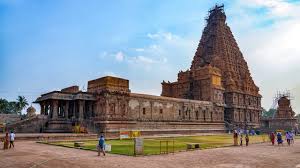The Divine Journey of Granite Temple Building
The vision was ambitious: not merely a renovation but a complete granite embodiment, following the traditions of the greatest South Indian temples.
NATURAL STONES
yuvraj
4/27/20253 min read


Temple building is as ancient as Hinduism itself. It is an artform, a devotion, and a science, perfected over centuries by dynasties like the Pallavas, Cholas, and Vijayanagaras. Over 1300 years ago, the Pallava kings pioneered the use of granite for temple construction, and their successors elevated this craft to divine heights. Just look at the mighty Bṛhadeeswarar Temple in Thanjavur, whose granite majesty has stood resilient against time, invaders, and nature's wrath. Raja Raja Chola's vision and the granite’s age-defying strength combined to create an everlasting monument.
Today, that timeless tradition of granite temple building has journeyed to the Southern Hemisphere. In Victoria, Australia, the Melbourne Vinayagar Hindu Sangam has embarked on a historic mission — transforming their beloved temple into a granite marvel, the first of its kind south of the equator. And leading this sacred endeavor is none other than Sthapati Purushothaman Jayaraman, a master craftsman whose life’s work is now intertwined with history.
Sthapati Purushothaman, who shared with heartfelt emotion the immense experience and sacrifices behind this divine project.
The Call of Duty
In November 2018, Purushothaman received the blessed call to undertake the granitization of the Vinayagar temple. Without hesitation, he left for South India to source the granite and draft architectural plans inspired by the ancient principles of temple construction. Leaving behind his family, he immersed himself fully into this labor of love for over a year — a task that would ordinarily demand five years.
The vision was ambitious: not merely a renovation but a complete granite embodiment, following the traditions of the greatest South Indian temples. A new design was drawn up, featuring sixteen Ganapathy statues, elegant decorative elephants, and a grand Rishabakunjaram motif — an illusionary marvel where a bull and an elephant share a single head, inspired by Chola artistry.
The Quest for the Perfect Stone
Initially, the journey faced setbacks. Granite sourced from Kanchipuram cracked and proved unfit for sacred work. With persistence and prayer, Purushothaman found a pure, robust granite deposit in Raasipuram, Namakkal — a land already sanctified by its towering Hanuman statue. Each block of granite was tested at IIT Madras to certify earthquake resistance, ensuring structural integrity for generations to come.
Work was carried out across three sites in India with sixty master sculptors working six days a week, chisel by chisel bringing sacred forms to life. From Mamallapuram, the carved deities and shrine pieces made their long journey across oceans to Melbourne, arriving in ten separate shipments.
Why Granite?
Purushothaman passionately explained the choice of granite. Measured at 8 on the Mohs scale of hardness, granite is a testament to resilience and endurance. Unlike softer stones like limestone or soapstone, granite demands not only physical strength but supreme craftsmanship to sculpt. Yet, it rewards this dedication by standing the test of time, absorbing divine energies, and radiating spiritual vibrations for millennia.
Our ancestors intuitively understood that granite held the five elements — earth, water, fire, air, and ether — in harmonious balance. It becomes a living vessel, ideal for enshrining divinity. Intricacies such as the gender-specific suitability of different granite types reflect the depth of ancient wisdom.
The Sacred Science of Temple Architecture
Beyond aesthetics, temple building follows the sacred principles laid out in ancient Shilpa Sastras. True Vaastu Shastra — often misunderstood today — is not merely about house placement but the profound alignment of time, space, energy, and form. The traditional Sthapati doesn't just build; he composes — using rhythm, proportion, and sacred geometry — to create a living organism.
The Kaasiyapa Shilpa Sastra describes the temple as "Prasaadam," "Divya-Vimaanam," and "Aadharam" — a divine dwelling for the Almighty. Just as the soul resides in the human body, the cosmic energy takes residence in the temple sanctum. The gopuram (tower), dwajastamba (flagstaff), and garbhagriha (sanctum) each correspond to elements of the human body and cosmic order.
The Bṛhadeeswarar temple's Vimaanam, engineered by the legendary Kunjaara Mallan Rajaraja Thachchan, remains an unsolved marvel to this day — a grand granite symphony that soars 221 feet into the skies without losing a beat.
A Living Legacy
Sthapati Purushothaman’s devotion and craftsmanship now join the lineage of temple builders whose creations stand as bridges between the human and divine. His journey is a reminder that temple building is not construction — it is consecration.
As we walk the corridors of the Melbourne Vinayagar temple, soon to be fully clad in granite, we do not merely step into a building. We step into a breathing, resonating cosmos, carved with love, sacrifice, and unwavering faith. A new chapter in the ageless story of Hindu temple architecture has begun — right here, in the Southern Hemisphere.

